

 |
Script- Graham Greene Director- Carol Reed Producers- Alexander Korda, Carol Reed, David O. Selznick Music- Anton Karas Photography-Robert Krasker (Academy Award) Editor-Oswald Hafenrichter Cast: Holly Martins- Joseph Cotten Anna Schmidt- Alida Valli Harry Lime- Orson Welles Porter- Paul Hoerbiger Anna's Landlady- Hedi Bleibtreu Baron Kurtz-Ernst Deutsch Dr. Winkel-Erich Ponto Popescu-Siegfried Breuer Maj. Calloway-Trevor Howard Sgt. Paine- Bernard Lee Hansel young Boy- Herbert Halbik |
This film was selected as the best British film by the British Film Institute in 2001. It was shot on location in Vienna, Austria, with most of the interior scenes being shot in the studios in London.
For a synopsis of the film see
http://www.filmsite.org/thir.html
or
http://www.sims.berkeley.edu/~michelek/Third_Man.html
For a detailed book on the film see "Der Dritte Mann - Wien auf den Spuren eines Filmklassikers" ( Brigitte Timmermann(text), Frederick Baker (photo)) now also published in English as The Third Man's Vienna - Celebrating a Film Classic See also Brigitte Timmermann's web site "www.thethirdman.net
W. Nassau was a photographer cinimatographer and location expert on the film. In 2015 he presented some memories of the time The Third Man, Exciting Events in Post War Vienna
In 2004 Frederick Baker filmed a documentary on the procution of the film.
Although somewhat slow and at time very annoying (projecting scenes onto
Viennese buildings etc) it does offer real insight into the film. It includes
interviews with Wells, Korda, Reed, and many others from the film.
See also
http://www.wellesnet.com/carol-reed-on-directing-orson-welles-in-the-third-man/
for the text of an interview with Carol Reed on the Third Man.
One of the attractions of Vienna for Reed was the destruction from the
war. Vienna escaped relatively unscathed compared to many other European
cities, but a number of buildings were destroyed when the Red Army captured
Vienna in '45 from the Germans. Here is a map
showing the buildings which were destroyed It is taken from an
out-of-print book Führer durch Wien und Umgebung
Publisher: Freytag-Berndt und Artaria (1955) (no author listed), and shows
the extent of the damage.
Wolfgang Waiss has a number of short films of various sites mentioned here
regarding the current Third Man locations.http://www.film-felix.com/?page_id=5352
He charges about a Euro for permission to download them for personal private
use.
I visited Vienna in the summer of 2002 for a month and became fascinated
with the film and especially with trying to ferret out the locations which were
used in the film. Some, like the Hoher Markt, were obvious, and some like
Josefsplatz and Schreyvogelgasse were listed in many of the guide books to Vienna.
But watching the movie (it shows in English every Friday and Sunday in the Burg
Kino on the Opernring 19) I began to realize that there were other locations
used as well.
After I got back from the trip, I bought the Criterion 50th anniversary
edition of the movie on DVD, which was recorded from a digitally enhanced and
cleaned master of the film.
I was surprised that no place on the web offered any of the exterior
shots in the film for visitors to Vienna to use in tracking down the locations of the film.
Using a movie like the Third Man as your guide around Vienna offers one a
way of looking at the city very different from the usual tourist tour. It makes
one highly conscious of details which one might well miss in the more casual
tourist process.
For those who want a quick guide to the city, a number of companies offer
"Third man" tours. The Vienna Sewer System offers a 20 minute tour of the
"sewers" (actually most of the so called sewers in the film are actually the
river Wien which flows along the eastern edge of the old city, and which was
covered in the late 19th century).
Below is a list of the locations in the film, with the thumbnail photos.
Clicking on the small photo will bring up a full size picture (640x480) of that
scene. Also with many of the locations is a picture of the same site in
Vienna now. What is astonishing is how little most of the locations have
changed in the past almost 60 years.
For more information about the Third Man, and other links see the page
There is a recent film about the Making of the Third Man
Since I only got the DVD after I left Vienna, and since I am not
going back there soon, I do not know where many of them were filmed.
Many are very distinctive and
probably easily found if I were in Vienna.
I therefor leave these as an exercise to the reader as they wander the
streets of Vienna to identify. If you want to
drop me a note at See also the article http://www.rouge.com.au/rougerouge/third_man.html
for a discussion of the cinamatography and the use of odd lines and
perspectives which give the film part of its disjointed feel.
J. Innerhofer has also been bitten by the thirdman bug, and as he
lives in Vienna, spent a lot of time at the end of 2002 and
beginning of 2003 finding many of the modern locations in the film. He
has found many which I missed, and also
has taken pictures of many of the locations, from as point of view as
close to that of the film
as he could. What is astonishing is how
little most of these locations have changed in almost 60 years.
He has also made a map with locations of
some of the scenes below. The map is labeled with the scene numbers given
below.
A Few of the places have also been found by Herb Ranharter the
Viennese/Californian artist.
http://www.delarte.com/
Also Alan McCrindle has taken modern shots of various locations.
G. Opelt has found a few locations and corrected some location errors I
made.
If anyone else has pictures of modern Vienna at the scene
of these locations which I could post (max size 640x480) it would also
be useful. In any case I hope you have fun
matching the vibrant modern city in 200 year old clothes to the scenes
from a film made at one of the low points in Vienna's history.
You can get in touch with me at J Sprung, a Cinamatographer from California has transfered the
coordinates of the map sites onto Google Earth. Here is
a link to a kml file which you read into googleearth and it puts
place markers onto Vienna for all of the locations of the scenes on the
map. Download it, save it and then load it into googleearth, or set your
browser to automatically use googleearth to render this file.
Or just enjoy knowing at exactly which lattitude and longitude the scenes
are at.
Vienna was divided into four parts from the end of the war to 1955.
After Martins' and Calloway's discussion in the bar, Martins is put up by
Calloway at the Hotel Sacher (the reputed inventor of the famous
Sachertorte). While going up to his room, Martins gets a phone call from a
Baron Kurtz, a friend of Lime's, and they agree to meet at the cafe Mozart.
There actually is a Cafe Mozart attached to the west end of the hotel, but
that is not the location of the Cafe Mozart in the film. At the time
the street around the real Cafe Mozart had been heavily bombed, and now
is the location of a memorial to the hundreds killed in the basement
sheltering during an air raid, and is also a monument to the treatment
of the Jews during the war.
The Hotel Sacher apparently formed the base for the all of the filming.
They put on up to 5 meals a day for the various film crews (a miracle in post
war Vienna for the Viennese crews).
Herb Ranharter has pointed out that the three windows on the building on
the left side of the picture just above Cotten's head is the Kapuziner
Gruft on the Neuer Markt.
Ie, the "cafe" seems to be just outside this building.
Kurtz takes Martins back to Josefsplatz to show what happened in the accident
which killed Lime. The discussion take place in the real
Josefsplatz around the statue of the Emperor Josef where "Lime" was
laid. Here is a current view of that
statue
just outside the door of 5 Josefsplatz. After
that Martins has further discussions with the porter.
Erik Iancovici has raised the issue of Lime's car driver. Martins
talks to most of the people at the accident site, except for Lime's
driver who was supposed to be the one that actually killed Lime. He is
mentioned and then forgotten.
The relation between Kurtz and Winkel is probably supposed to be a
homosexual one. Kurtz is seen holding the little dog at the graveyard at
the beginning. Then Winkel has the dog in his house and claims it as
his. Winkel here comes out of Kurtz's house. Later, Martins finds Kurtz
and Winkel together in dressing gowns in Kurtz's house.
That night Anna and Martins go back to Lime's building to talk with the
porter, and find he has been murdered. A small child (Hans) accuses
Martins of the murder, as he had seen Martins and the porter arguing.
This location is the same as that in 040 and
053, just looking
toward Am Hof, rather than up Ledererhof. See the
current location picture. The space in front of the postered wall in the
film has been filled with a building today.
After leaving Anna in the movie theater,
Martins goes back to the Hotel Sacher to get a taxi to take
him to Calloway. A taxi is waiting for him, and sets off on a
hair-raising ride through the streets of Vienna. A whole sequence of
scenes flash by.
The most famous scene, the Ferris Wheel meeting between Martins and Lime
which ends with the cuckoo clock speech, occurs here . In English, the speech
begins: " As the fellow said: Under the Borgias..." However in the German
version this is altered to read
"Wie Mussolini gesagt hat: Unter den Borgias...". I.e., the origin of the
speech is attributed to Mussolini, instead of "the fellow". In my mind this
weakens the speech, and it is also not something Mussolini is likely to have
said.
Here and here are pictures taken out of the
cars of the current Ferris Wheel. Notice that the shapes of the
cars have been modernised. However, Lime's words, about the people
looking like ants, would be as chilling today as then.
While waiting for Lime to walk into the trap,everyone suddenly see a shadow
against a building.
This balloon man was a well known character in Vienna after the war,
and was called either "Wurzelsepp" (a somewhat derogatory term)
or "Very Much Obliged" (one of his few phrases in English) by the people in the American Library
in Vienna, where he would often spend his afternoons [contributed by Hans
Burndorfer].
Judy Schulman comments that the location across the street is
Alserbachstrasse 41. Her great uncle
Rudolf Gesund owned the Café Esplanae from
1921-1936, and that name is
briefly visible. Also in 1942, Pokorny is listed in the Suedostdeutscher
Wachdienst as located at Alserbach 41 (see bottom right corner
of the page).
I have been assured by w. Nassau who worked on the
film, that this is not true. While Wells complained
constantly of working in the sewers, he was also very professional, and acted
in all the scenes he was in. No doubles were used for
him.
Martins finally shoots Lime (off camera, which has led to the suggestion that
Lime shot himself. However to me his nod to Martins after hearing Calloway
shout to Martins to shoot if he sees Lime, clearly indicates not only that
Martins shot him, but also had Lime's permission to do so.)
In fact a careful viewing of the film shows that almost all of the
scenes in this last ride were shot around that Jugendstil monument
with figure with a bowed head. That monument reoccurs in almost every
shot of this final graveyard scene. Every time the jeep stops it is in
front of this monument. And all of Anna's walks, in one direction or
another, are around this monument.
Third
Man tours
There are also tours which give one a both a glimpse of the sewer system,
via an entrance like the one used by Harry Lime to escape Holly Martins in the
famous chase scene, and also around some of the main landmarks from the movie
(Josefsplatz, Michaelerplatz, Am Hof, and Schreyvogelstrasse).
Vienna in the Footsteps of the Third Man

I was in Vienna at the time of the infamous
rains of the summer of 2002 which
flooded most of central Europe. (The picture is of Prague in the Czech
during that flood.) Fortunately Vienna was protected by the
auxiliary bed of the Danube which had been dug about 30 years earlier to
protect it from just such a flood. It worked, but the "sewer" tours were all
canceled. Actually, some of the locations of the sewer chase scenes
do not exist,
but were created in the studios in England. (One story has it that it was
because Orson Welles refused to work in the sewers, but others dispute
that. See this
discussion of the making of the film.)
http://german.about.com/library/bl3rdm_linx.htm
 to tell me where
the location is, I would appreciate it.
to tell me where
the location is, I would appreciate it.
 (Sorry, because of spam, that address is an image-- you
need to type it directly into your email program).
(Sorry, because of spam, that address is an image-- you
need to type it directly into your email program).
Movie Exterior events
Locations
Map of Vienna showing the locations shots for the
third man that we have been able to find. The blue circles indicate more
detailed maps from the list below.
The film begins with a series of quick shots of various famous
locations in Vienna. Some are easily
identifiable, others are more obscure.
Introduction.

Location:
The Strauss monument in the Stadtpark just near the outlet of the
underground Wien river.
http://www.vienna.cc/deutsch/strauss.htm


Location:Beethoven Denkmal
Monument in honour of Beethoven.
See for example
http://www.wien.gv.at/ma42/images/beethoven1.jpg

Location:Reichsbrüke?
Occupation Zones of Vienna
Whether signs in the film correspond to any of the actual zones I am not
sure but they seem to. I suspect many of the signs were created for the film
itself.


Location:Schoenbrun
Innerhofer
This is the right wing of
Schloß Schönbrunn from the front entrance. Schloß Schönbrunn was
used as the British Headquarter in Vienna
http://www.vienna.cc/wienpix/schoenbrunn11.jpg(the same part of the
palace, seen from the north

Belvedere-Upper entrance
http://www.vienna.cc/deutsch/belvedere9.htm

West Bahn Hof.

Location:Justizpalast
See 19.
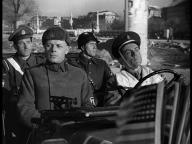
Location:Morzinplatz
Innerhofer The pillars
belong to the old Salztorbrücke along the DonauKanal. The location is
just behind the pile of rubble in picture 98.
http://www.wien.gv.at/media-wien/images/blabi17.jpg

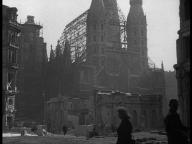
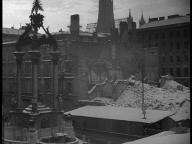
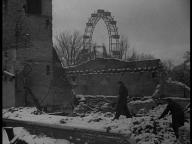

Location:Justizpalast
Sign says Inter Allied Command. Note woman on upper right appears to be taking
a photograph of the film makers. This seems to be on the steps of the
Justizpalast.
Innerhofer The Inter Allied Command
was located at the Justizpalast (palace of
justice) to left to the Parliament (Schmerlingplatz)
http://www.aeiou.at/aeiou.encyclop.data.image.b/b397245c.jpg
the text to the picture: around 1950 change of the guards (USA - USSR)
picture of today:
http://www.wes.at/images/foto/fotos%20aktuell/justizpalast_wien.jpg
Lime's Apartment
Holly Martins, an American pulp cowboy fiction writer arrives in Vienna at the
Westbahnhof (West train station) and says he is going to 15 Stiftgasse. He
actually goes to 5 Josefsplatz, the building directly across from the national
Library (part of the Hofburg). The Josefsplatz square contains a statue of the Emperor
Josef II on a horse, and this statue is referred to by the porter elsewhere in the
film. That the film gives a different address to 5 Josefsplats, when using
the right address would have made no difference whatsoever to the film,
is typical of this movie. The
reason is unclear. Perhaps they had originally wanted to use Stiftgasse,
and this was a leftover of that in the script. Or perhaps the writer and
director were immersed
in a mood as weird and dislocated as the film itself.

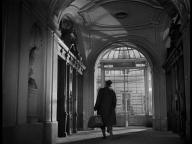
Location:Palais
Pallavicini
Martins entered into the front door
of 5 Josefsplatz, and walks down the lobby, at the other end of which is
a set of glass doors leading out onto seemingly another street as
emphasized by the people walking by in the film.
Those glass doors actually lead to an inner
courtyard of the building. Here is a shot
today. and here is another

Location:Palais
Pallavicini
The interior of the building is very opulent, far more so than would be
suggested by the building front.
The interior of this "Palais
Pallavicini" , built in 1783,
belies the plainness of its exterior. According to Innernofer, an
architectural guide says that when it was built, complaints
were made about the plain exterior.

Location:Palais
Pallavicini
The porter (Paul Hoerbiger), one of the charming minor characters in the movie.
This scene includes one of the charming "errors" in which the porter says
"He is probably already in hell" while pointing up with his thumb, pause,
"or maybe in heaven" while pointing down. The German language
edition of the film "corrects" this error by having the porter make the
traditional association of place with direction. I suspect that this mistake
may well have been deliberate, emphasizing the porter's tenuous grasp of
English, while enhancing the feeling of dissociation that the film struggles
so hard to achieve.
Here is a current interior shot of
this landing.
Lime's Funeral

In the graveyard, almost all of the characters seem to be standing in the
same place in their individual shots.
In the background of almost every shot, even though the characters
are supposed to be well separated (by 100 meters in the case of Major
Calloway), is the same dark gravestone marked
Ruhestaette der Familie Elchinger (it is at Group 43A, Row 14, Number 16
according to Christopher Turner in an email in Aug 2016). In this scene it is to right of Baron Kurtz.
Was this on purpose or was it the only place where they could set up
their camera for some reason?
Here is a current view. How was the church
in the background hidden in the film?


Current view

This grave is located in section 43A behind (Northwest) of the
Friedhof's Kirche.
This and this are two other modern shots
of the grave site.
In the book,
"Der Dritte Mann - Wien auf den Spuren
eines Filmklassikers" ( Brigitte Timmermann(text), Frederick
Baker (photo)) now also published in English as The Third Man's
Vienna - Celebrating a Film Classic, it is suggested that some of the scenes at the
graveyard were filmed in the film studio in London, which would explain the lack
of the Friedhof church in background. See also http://www.screenonline.org.uk/film/id/591597/
which says the same thing. This would however make the
continual reuse of that gravestone completely incomprehensible. The
various scenes are supposed to be scattered around the grave, with
Calloway being many meters away from the grave, and yet exactly the same
headstone occurs in each and every shot. This would be ridiculous if
the scenes were shot in a studio.
Michel Schreiber has pointed out that in some of the scenes in the graveyard
there is clearly a wind blowing (tree leaves and hair moving), while in others,
it is not. This would imply that this scene, with no leaf movement, was shot in the studio. The
gravestone layout is also different from what occurs in the cemetary.


The imposing monument at the corner of two walkways in the cemetery
is that of Heinrich Freiherr von Hess. It is on the main entrance road
to the cemetery (Tor 2) and directly across from the memorials to
Mozart, Beethoven, Strauss, Brahms, and Shubert.
Here is a another current picture

Location:unknown
See the Irish Cross seen through
the window of the car in the background of this scene in the Graveyard. Also
note the very white and dense tombstones in contrast with the very wooded
and somber shading of the tombstones in the Friedhof. Almost certainly
filmed in some graveyard in England and back projected . Why not film the real
cemetery and back project that?

Location:unknown
See another Irish cross in background and the almost complete lack of trees
and vegetation in the graveyard outside the car.

Here is a current view along this
road.
With Calloway in Pub
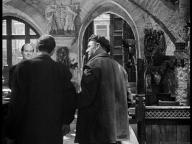
Location:unknown
No idea where this is. May not even be in Vienna.
Apparently many of the indoor scenes were shot in studio in London. Is this
one?
Meeting with Kurtz at Cafe Mozart

Location:Neuer Markt
This is not the real Cafe Mozart which is just W of the Hotel Sacher.
rather it was filmed in the the Neuer Markt, but
the Donnerbrunner which dominates this is not visible to me in the film
frames.
Innerhofer Yes it is Neuer Markt, you can see the tower
of the Stephansdom on the
right side.The Donner Brunnen was partly destroyed by bombs, but you can
see it to the left of the lamp post (with the clock).
It is covered with wood (as
is always done during winter)
Here is a view of the Neuer Markt in the winter
of 2003. Note how little the square has changed, and that the
Donner Brunnen is again covered.

Compare Joseph Cotten's right ear with that of the person in the car
sucking his parrot bitten finger in the ruined car in frame 071.

Here is a current picture of that
doorway. And this is another
with today's (rather better dressed) porter guarding the door.
Location:unknownPorter at Lime's Apartment
Martins goes to see Anna act in a play and talks to her afterwards. They go
from the theater to Limes apartment, where Martins tries to get more
information while Anna wanders familiarly throughout the apartment.
[ William Kellner has reported that the lead actor in the play in which
Anna acts at the Josefstadt theatre was Karel Stepanek, who later
made many films, including the role of Admiral zur Zee Lutgens in the
film "Sink the Bismark".]

Location:unknown
This interior of Lime's apartment has a view out the window which
seems to face onto a very near wall of the next building. The
Josefsplatz actually fronts the building and the nearest other building
is about 50 meters away.

Location:unknown
The scene through the glass of Lime's window looks nothing like the
scene
on Josefsplatz. The Bibliotech would be outside any window across a
large
square (Josefsplatz) and about 50m away. Instead we see two well
kept buildings facing
each other with the left one have a high church tower. The well kept
nature of these buildings seen through the window seem at odds with the
rather decrepit look of the two buildings seen in the next shot out the
window.
Innerhofer I found a church with a very similar tower (Schottenkirche at the
Freyung)
http://www.museum.vienna.at/images/Restitution/70420_gross.jpgbut
it has to be another tower:
the tower in the movie has a real window and it is impossible to see the
Schottenkirche like in the movie.

Location:Ledererhof
While talking to the porter, Martins looks out the window to this scene.
Again, the view Martins gets of the street out the window is not that of
Josefsplatz.
This location is reused later in the film (See figure 053) supposedly very far from the apartment.
Innerhofer has found the location in the Ledererhof just off Am Hof.
This is also
where location 049 was shot, but facing to the west rather than the
North. Here is a current shot of the scene.
Anna and Martins now go to her apartment, where her land lady (brilliantly
played by Heddy Bleibtreu) is wrapped in a comforter and is complaining constantly
in German how the presence of the police is bringing down the reputation of
her building.
Anna's Apartment

Note that the time is approx 7 (or perhaps 25 to 12). on
the clock on this central fire station front.
Here is a current shot from this
location. Notice that the clock has been removed from the
Firehall.
They meet another of the wonderful minor characters, Anna's
landlady, played by H. Bleibtreu, who plays all her scenes wrapped in a
comforter and complaining "When I imagined the Liberation it was very different".
Bleibtreu, the doyen of the Vienna National Theater, was flown to
London to film some of he indoor scenes. This, at age over 80, was the
first time she had ever been in an airplane.
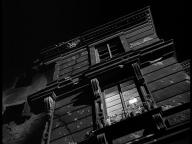
Location:unknown
Martins and Anna look up at the window of Anna's apartment.

Martins finds Kurtz playing violin in the Casanova Club (6-8 Dorotheer gasse), and also finds
Popescu, another of Lime's friends present at his death.They tell him
about Dr Winkel, Lime's physician, who arrived after the accident.
Martins goes to find Dr Winkle. [The Casanova Club was still there as
recently as 2006, but even the name has now disappeared from the
building. It was on the north side of the street, just off Graben,
right next to the old and very funky Cafe Hawelka.]
Dr Winkel's Home

Location:St. Ulrichsplatz
This entrance
to Dr Winkel's house seems to have nothing to do with the
building he takes his bike out of in the next picture. But note the bicycle.
Innerhofer suggests that it is at St Ulrichsplatz 2 which is across the
city (off Borsegasse)from the house in 045a.
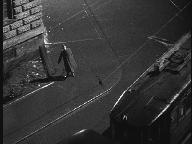
While Anna is interviewed by Calloway in the International Police
station, Martins waits outside on a corner. The 71 tram on a one way
street (ie, the tram traveling to the right is also on the left or center
of the street) which would probably place it
at the corner of Schellinggasse and Schwarzenbergstr. The tram no
longer runs along this loop.
The next day, after Martins has spoken to Winkel, and has met Kurtz
and Popescu at the Casanova Club, the conspirators (we see
Winkel ride out on his bicycle, and Kurtz and Popescu striding out) meet on
a suspension bridge apparently over the Danube. None of their
homes look like the entrance to Winkel's which we see in 044.
Conspirators and the Suspension Bridge
The location seems to be on Boersegasse just at the corner with
Tiefer Graben.

Location:Reichsbrüke
The conspirators
meet on the suspension bridge. Note that there are four
in the group. Harry Lime is presumably the one
second from the right.
Innerhofer the Reichsbrücke (Bridge of the empire)
was the only bridge across the
Danube that was not destroyed during WW II. During the Russian occupation
the bridge was
called "Brücke der Roten Armee" (bridge of the red army). It was build in the 1930ies. On
August 1 1976 it collapsed.
http://www.wien-vienna.at/reichsbruecke.htm or here
The church in the background is usually called Kaiser Franz Josef Jubiläumskirche, it was
build in 1898 for the 50th anniversary of the Emporer (offical name "Kirche
Heiliger Franz von Assisi")
http://www.wes.at/images/foto/fotos%20aktuell/mexico.jpg or
The bridge was rebuilt but not as a suspension bridge. Here is a current view.

Location:Reichsbrueke
See the four men (tiny) on
the bridge with the second from the left with a light coloured coat. He
was the one (presumably Lime) the other three meet on the bridge.
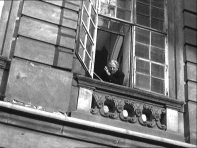
Martins makes an appointment with the Porter who is willing to talk later that
evening when his wife is out. Michel Schreiber points out that the window the porter leans out of is not that
of 5 Josephplatz but of the Bibliotek across the square from Lime's
apartment.
Chase by Small Boy


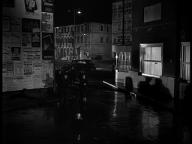


Location:Schauspielhaus
Martins and Anna run into a
theatre to escape the crowd.
Innerhofer :the Cinema was called "Heimatkino", today there is a theatre
(Schauspielhaus Porzellangasse 19)
The yellow sign above the door says "Kino ausgang" and seems to be a
remnant of the old cinema.
The movie playing while they try to plan their next move is Maresa, a
popular film at the time about the Vienna Lippizzaner Horses. (from Hans
Berndorfer).

Location: Schauspielhaus
This
is the ticket counter for that theater.

Location:Ledererhof
Martins looks out and sees his nemesis, the lone child coming around
the corner. This
corner is precisely the one that Martins saw looking out the window
of Lime's apartment(040). It seems they have run right back across Vienna
to Lime's apartment:-)
Current view by G Opelt
Here is a map of the various locations
along the taxi ride made by G Opelt. They show just how
wild the taxi ride really was!
Taxi Ride


Location:Minoreten Kirche
I
did not know this scene whose only
identifying feature seems to be the
statues as doorposts on the left hand building, and the arches to the
right. However,
Innerhofer identified it as the Minoretten. The
street in the front is Abraham a Sancta Clara Street (hard to find in a
map) it connects Minoritenplatz with Bankgasse
http://www.vienna.cc/wienpix/minoriten1.jpg
This picture is from Metastasiogasse, the scene in the third man shows
the left edge of the church (arcades!!)
And Here is a current view.

Location:Minoretenkirche
This is clearly the same corner as in 055 but from a slightly different
shot.(See the church arcades to the right, and the style above the windows
of the building in the background.) This corner is reused in one of the
final scenes in the film. (see 131,
133 below)
And here is a is a current
view.

Location:St. Ulrich's Platz
The style of the tower on the building in the background, and the street
sign just above the bum's shoulder might give clues as to where this is
located.
Gerald Opelt writes:
" The location of picture number 57 is Ulrichsplatz (left you can see the
wall of the church). Source is
The Third Man's Vienna - Celebrating a Film Classic ISBN: 9783-9502050-1-5
(www.shippenrock.com)
but I also have checked it!" Here is a current
view taken by G Opelt
This places it right beside Dr. Winkel's home, and, as expected,
is totally disjointed from the rest of the taxi ride. (If one imagined that
the ride was real, it really was the Taxi ride from Hell, especially
since parts occur in London)
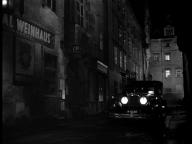
Location:Schoenlaterngasse
The clock, or sundial on the tower behind the taxi seems the only clue to
this shot. This is almost certainly Schoenlaterngasse (see 104 but in the opposite direction) Here is a current shot G Opelt

Location:Schoenlanterngasse
This seems to be the identical street to that in 058 but with the camera
now located where the car is in 058 (See the sign, Special Weinhaus on the
left in 058 but on the right here. Opelt Identifies this as
Sonnenfelsgasse, at the corner of Schoenlanterngasse. The two "Weinhous"
signs are on the two edges of the same shop at 17 Sonnenfelsgasse.
104
Here is a current view G Opelt
Notice the person on the street. What in the world is that man doing
lugging a double bass out of its case through the night streets of Vienna?
Here is a brighted version of that
picture making it clear that actually is a double bass. While the scene
flashes by very rapidly in the film, this incongruity probably registers
subconsciously on the viewer-- or the director was just having fun. This
scene has been misinterpreted as a "goof" with the double bass neck
being mistaken for a sound mike boom (the nutbox of the double bass looking
like a microphone hanging over the street).
W Nassau says that finding a character like this on the streets of
Vienna was nothing unusual-- the musicians would lug their instruments
from Heurig to Heurig, and this musician would probably be too poor to
afford a case. Reed was very open to grabbing the opportunity to involve
unusual people into the film when he came across them.
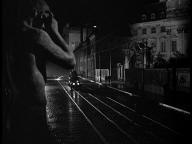
Location:Salesianerinnenkirche
This street
is at the entrance to the Salesianerinnenkirche (see 061)(Innerhofer)
Note the truck in the background wetting down the streets to give them the
black, reflective look Reed wanted.
Here is a current shot of the street.
The statue was probably placed there just for the film. At least it does not
seem to exist today.

Location:Salesianerkirche
The church to the left should make this location easy to find. I did not know
it however.
Innerhofer This is about two house to the left of 060 the Kirche des Ordens der
"Heimsuchung Mariä" (called Salesianerkirche)
http://www.kidsweb.at/wienweb/landstrasse/images/heims6.jpg

Location:Music School
This courtyard is probably impossible to identify uniquely.It looks too
much like any other courtyard in Vienna.
Note the strange situation. In both 061 and here there is no hint of rubble
anywhere, and yet after the lecture, and Martins' clamber up the stairs,
being bitten by a parrot, and climbing out a second story window, finds
himself on
a huge area of rubble for him to clamber over.
And despite my doubts, Innerhofer has made an identification. This
is the inner courtyard of the building in 061
This building is now a Music school so can be entered. The film camera
position was inside a passage way which was closed when this picture was
taken.
Lecture

Location:unknown
See the putative entrance to the
stairs on the left,
although whether this is the circular stairs in the next shot is very
unclear.

Chase by Thugs

Location:unknown
Identifying a heap of rubble seems impossible.


Here is a
current view

Location:unknown
The location of this rubble is almost impossible to place.

Current View

Location:unknown
Again the location of this car wreck is impossible to know.
Innerhofer:Today i noticed that there is a church in the background of
070. (you can
the a crosses on the top) I think that this is the front of
Maria am
Gestade. The camera location would be at the corner
Neutorgasse/Heinrichsgasse.
Look at 070-current the yellow house on the right side seems to be
the one above
Holly (look at the corner).

Location:unknown
Compare the ear of "Martins" in this shot of him in the car, with that in 072 and
in an early scene of Cotten in 036. It is not the same. This is probably a
double, and thus the finger in the mouth to hide the fact. Why the double
was needed here is unclear since Cotten takes his place in the next shot.
John Sprung (Associate Member of American Society of Cinematographers) states:
What seems most likely here is that Reed didn't get enough
coverage shooting
with Cotten as Martins, and the next day the editor told him that
there was
a problem. He may even have looked at a rough cut. The idea is that
Martins shakes the thugs by hiding. To show that, we really need a
passage
of time cutaway. To stay on schedule, they couldn't go back another
night
with Cotten, so Reed probably sent a second unit with a double. Even
so,
what the second unit did doesn't sufficiently show the passage of
time, and
this is perhaps the clumsiest moment in the film.
Also, when in this
chase did Martins have time to make himself a bandage?

Location:unknown
This is almost certainly Cotten again.

Having escaped from Popescu's thugs, Martins goes to see Calloway,
discovers that Lime was a dealer in adulterated penicillin, and
responsible for the death and destruction of a large number of people. He
decides to give up and visits Anna to say goodbye. In the room is a cat
which apparently would only warm to Lime.
Cat and Doorway

Location:unknown
The cat seems to change through the various scenes. Here is the first shot on the bed in Anna's
apt.

Location:unknown
And just leaving the room.


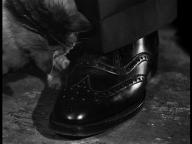

Revelation








Martins chases Lime.
Chase of Lime


Kiosk


If you brighten the
scene, you can also see the tall black pillar of the statue extend
above the top of the kiosk, partially obstructing one of the
windows of the house across the square. The cameraman has brilliantly
hidden that top of the pillar statue against the dark of the roof and
of the sky.
Note that the camera pans back to allow Martins to come to the cherub
basin and splash first himself and then the cherub with water from the
almost full basin. But this would have been impossible. From the camera
shot of the kiosk, the statue and the buildings across the square,
the cherub must have moved about 30 feet out into Am Hof when
Martins splashes in the water. The shot would be impossible from where
the statue is located in the entry shot ( 090
and 093) to get the
angles on the statue and the buildings.
This kiosk is probably a movie prop.
Here is a picture of the Am Hof today from
the point where the film shot this scene.
However
entrances to the sewers are hidden in such kiosks elsewhere in the city.
One is along the (buried)
Wien river at Beethoven's Platz, and is used by some of the Third Man
tours as their entrance to the river. It is also probably the place
where Calloway, Paine, and Martin's entrance down the stairs (just after
the scene in 096) was filmed.
In this scene also look at the building across the square at the right.
Although in shadow, the diagonal across the left front of the building
is the same as in the child chase scene 049. Also this is the
building which had the
front door to Anna's apt building in scene
041 and 043.


Harbin's grave
Calloway now suspects that Lime may not be dead, and they dig up his grave.
and find the body of Harbin, one of Lime's confederates and the procurer of the
penicillin which Lime diluted.

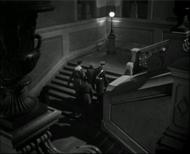
The Russians decide
that Anna was really from Czechoslovakia and belongs to them and send
four police to pick her up. [Again a great scene with the Landlady and
the four soldiers display their nationalities by how they treat Anna.] Anna has been picked up by
the police and driven to the police station. She is escorted up the stairs
of the international police station where Holly Martins was waiting for
them.
This appears to have been the stairs inside the
Palais Auersperg. (confirmed by Foda).
Kurtz's House

Location:Morzinplatz
Martins calls at Kurtz's
house, which is a very impressive building.
The pile of rubble
in the background is the remains of the Gestapo Headquarters (Hotel Metropol)
Innerhofer
It is the house at Morzinplatz 3. The
building is still there but the facade was destroyed (or how you could
name
something like this) without any reason in the 60ies. The building is on
the cover of a book
"Wien Stadtbildverluste seit 1945" (Losses to
the Vienna Cityscape since 1945)
http://www.gbl.tuwien.ac.at/_docs/entwerfen/archiv/id/ort/images/detail3.jpg
is a current picture of the scene. The left building is Kurz's house,
while the modern building on the right is at the place
where
the Metropol was.
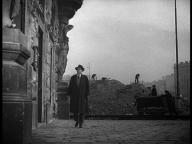
Location:Morzinplatz
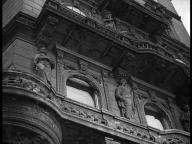
Location:Morzinplatz
Wheel

Location:Prater
The intimation that the huge Ferris wheel is just next to the Kurtz apt
is not correct-- they are separated by a river and many
kilometers.
Here a view from a similar location today.
Note the change in the trees.
Cafe Marc Aurel and Trap for Lime
After the meeting with Lime, Martins first tries to bargain with Calloway for the freedom
of Anna in return for betraying Lime.
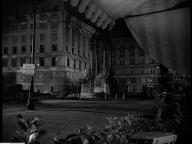
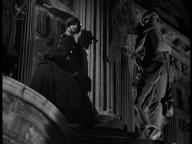

Location: Schoenlanterngasse
There is a set of 5 street scenes which are supposed to represent all the
streets that the soldiers etc are watching in wait for Lime. Most of these
I do not recognize.-- This street has been found by the artist, Herb
Ranharter. (See 058 )
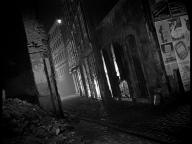
Location:Judengasse?
This seems to be the same as in 073 from the
opposite direction. See especially the pattern of the doors on the right
side here. This is also the same street that Harry flees down in 118. Current view by G Opelt

Location:Schoenlanterngasse
This is the same street which the taxi drove down in the scene 058 and is thus almost certainly Sonnenfelsgasse at the
corner with Schoenlaterngasse.
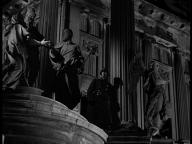

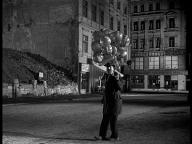
Also note the side awnings on the Cafe Marc Aurel in the
background which would have made it difficult for Martins to look out
the windows and see the statue.
Here is a current shot of this scene.
Unfortunately what was the Cafe Marc Aurel is undergoing
renovations. It is currently ( and was also at the time of the
film) a Stationary shop, and the Cafe was created for the film.
Current(2008) view by G Opelt a with the
renoations gone.
Note also the drastic change to the building at the end of the
square from frames 110 and 111. In those shadow shots, the wall had large spaces between
the windows onto which the man's shadow could be seen, and was a
three story building. Suddenly
that end buildings windows take up the whole of the wall, making
any shadow hard to see, and the building itself it more than five
stories tall.

Note the absence of any soldier on the
platform, the absence of the balloon seller, and the sudden presence of a
host of horse drawn carriages from Limes viewpoint. Note also how brightly the statue is
illuminated, though it was very dark when those soldiers clustered around it
were seen. In those shots the square was also empty.
Across the square and to the left of the Marriage Statue are the
three ruined arcades visible in the pictures taken of the Statue
down Judengasse.

Chase
Lime comes into the back door of the cafe, where he sees Anna and Martins
and discovers Martins' betrayal. Just about to shoot him, Lime must flee
instead as Paine sees him through the cafe door.
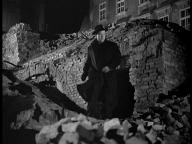
Location:No.4 Berghoff
Again, a huge mound of rubble.--
Kurt Kospach has identified the building in the background as Berghof Nr. 4
It is of course on the opposite side of the Hoher Markt from the "Cafe" he
was supposed to have run out the back door of, but is at least close by.

Location:unknown
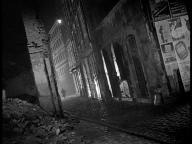
Judengasse? This is the same as 105 and
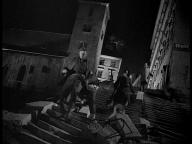
Sewer and Tame Rat
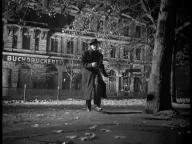
and ends up at this entrance to the sewers.
The Sewer board of Vienna offered
tours until 2002 which enter the sewer through an octagonal petaled entrance like the
one Lime uses, although the current one is aluminium, while the
movie one seems to be
painted steel. This modern entrance is just across the street from the Secession Building
near Karlsplatz. The tree seen here beside the entrance is still there
(bigger) at that entrance.
Note that this is in the opposite direction from the Hoher Markt
than the St Ruprecht's stairs down which Lime runs to get to this
entrance.
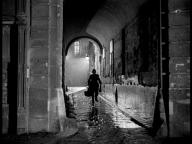
Location:Ballgasse
-- found by Herb
Ranharter.
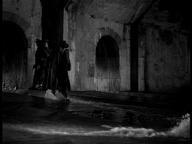

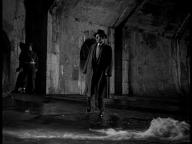
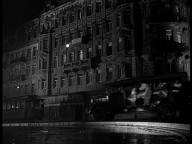
Location:Alserbachstrasse
There are two places where the sewer police enter octagonal entrances to the sewer.
This is the second ( the first was the same place where Lime entered).
Note the building in the background, with what looks like "POKORNY" on the
side).
Innerhofer suggests this entrance is just outside Alserbachstrasse 40. This is
across town from the covered River Wien which Lime runs through.
Alserbach was another stream (Bach) running through Vienna (eg, on
maps from 1760) which was covered over in
the late 1800s.
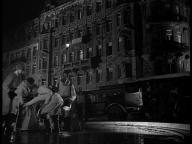
Location:Alserbachstrasse
A streetcar also goes by and the number can just barely be made out as the
number 5. The present number 5 streetcar goes from the Wien Bahnhof Nord, via
the Franz Josef Bahnhof and Alserbach Strasse
to the WestBahnHof.
Innerhofer The numbers of the streetcars have not been changed since 1907
in 1946 the endstations of Number 5 were named "Mariahilfer Straße" and
"Praterstern".

Lime is chased through the sewers by the sewer police,
and escapes across a "waterfall". Unlike other parts
which were filmed in a mockup in the studios in
London, this is an actual location in the sewers as
picture by Michel Schreiber shows. It has
been suggested that because of Orson Wells' reluctance
to work in the sewers, the person here is a double and
perhaps also, as suggested by Schreiber, because of
the danger of this run across a (slippery?) narrow
ledge.
On the day when setting up near this "waterfall"
suddenly they were deluged by a brown flow of water.
Above it was intermission
time in one of the opera houses. The sewer police had
known of the imminance of this event, and enjoyed the
discomfort of these guests in their domain.
Grating
Lime is trapped in the sewer, and after Lime has shot Sgt Paine,
Martins takes Payne's
revolver and goes after Lime, who was injured by Calloway's shot. Lime ends up on an iron
staircase to a sewer grating in the road, which he is not strong enough to
lift to get out of. (He must have put down his gun in trying since both hands
come through the grating in the next scene.)
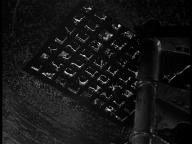
Location:unknown
The scene with Lime reaching his fingers through the grating
lies somewhere between pathetic and bathetic. However the transformations
of the grating
is almost as interesting. In this scene shot
from below it is clear that the
thickness of the metal on the grating is about an inch.
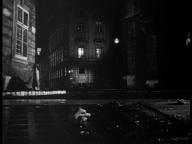
Location:Minoreten Kirche
However, looking at Lime's finger reaching through the grating, it is clear
here that the thickness of the metal is less than a quarter cm.
Note also that we are back at exactly the same corner as we drove over so
quickly with the taxi in 055 and 056. One can recognize the arcades to the right
and the window styles on the building in the background in the center.
It is surprising that the grate is not visible in the taxi picture (056).
The camera in that shot must have been set up right on top of the
grate.
Here is a current shot from this same
location. In the 1980s a new subway line was run right
under the Minoretenkirche, which probably resulted
in the moving of this storm sewer grating.
While a grating exists near this
corner, it is not in the same place as in the movie.
Also, under the current grating is a shallow box,
not a set of stairs.

Location:unknown
Two more shots from below and above show the same. Here we
see that Lime is holding the gun in his hand as he reaches for the grating, but then see that his fingers of both hands poke out maximally.
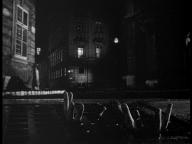
Location:Minoretenkirche
Lime's Burial
Finally we have the real burial of Harry Lime.
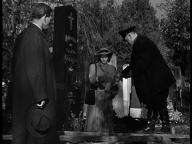
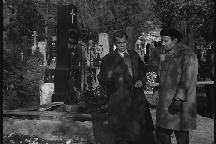
This shot shows that Lime's grave is abutting right onto the Elchinger
grave. The plank rests on the Elchinger gravestone. This modern shot shows that Lime's grave is
now the site of a pathway through the cemetery. Were the authorities
ashamed of this inhabitant of their graveyard?:-) Should a gravestone
commemorating one of the more famous of the Friedhof's (imaginary)
inhabitants be erected?
Here is another modern shot
from the same angle as the film's.
The suggestion has been made that Lime's grave was that of Herr Gruen,
in the grave to the left of the path (He was buried in 1948).
However the location of the grave in the film seems to me to be closer
to the Elchinger grave (ie, it is in the pathway) than is the Gruen grave.
Note the very obvious church in the background of this modern shot. While the trees were much thicker in the film shot, and might hide the church, the same does not seem to be true of the shots in 25 to 28 in which the church should have been visible.
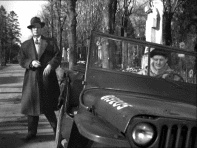
Calloway offers Martins a ride-- at the Jugenstil angel, which
was ahead of Anna both in the previous scene and the next one.
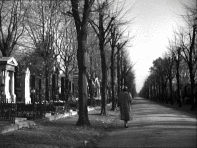
.
And here she is walking down the road itself, but her location along
the road is precisely the same in the previous shot 134b (and behind
134c).
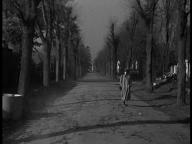
On the right you can see the white Jugendstil monument with bowed head,
which is just visible through the trees in the film.
Far in the background is a tall pillar which is the monument to
the Soviet soldiers who died in Vienna during the occupation.

Location:unknown
While the view out the sides of
the open top jeep have a graveyard crowded
with tombstones (including Irish crosses) with essentially no vegetation
and certainly no trees every 20 feet or so. Again the coloring of the
stones is light and bright when seen from the jeep, but much darker when
seen from the road. This graveyard on this ride is almost certainly a back
projection shot in the studio, but why did they not use shots of the
Friedhof cemetery in Vienna for the back projection, rather than
some cemetery in London?

Although some of the scenes are definitely from the Friedhof,
such as this one. Here is
a current shot of the gravestones from this scene
taken by Michel Schreiber. Note that while the weeping woman
just visible over the windshield is stll there, the two other
monuments (the cross and the gabled-corniced stone) have
collapsed or been vandalized.

Having passed Anna, Martins decides to get out of the
jeep, with Calloway saying "Be sensible".
Here is a current shot of the background
graves by Michel
Schreiber.

After a long, almost two minute shot of her walk along the cemetery road, with
Martens waiting for her, Anna ignores him, and the movie ends.
There is no monument at the far
end of the road, so it is not just further down the road
of #135.
This is a current view. This is the same
road as in 135 but from the vantage of the monument at the end of the road in
135. Ie, Anna seems to have turned around to walk past Martins.
Note that in 135 the sun is clearly on the left of the picture (see
Anna's shadow) while in 137 it is also clearly on the right (Lack of
Martin's shadow and the shadow of the trees. Either she
has been walking all night down the same alleyway, or she turned
around. That the shadows are dominated by tree shadows which stretch all
the way across the road makes it difficult to see this change in
direction of the sun in the movie. Since the shadows fall diagonally
across the road in the same way in both shots suggest that this detail
was important for the filmmaker-- they shot 137 at almost the same time
of day as 135, although in 134b and d, the shadows are almost directly across
the road.
This final long walk was apparently shot by
uncredited German cameraman Hans Schneeberger (
http://www.screenonline.org.uk/film/id/591597/.
This scene was apparently the first one shot in the filming (W. Nassau)
Due to the insistance of the British unions, none of the Vienese
cinematographers were allowd to have credits in the film (W. Nassau).